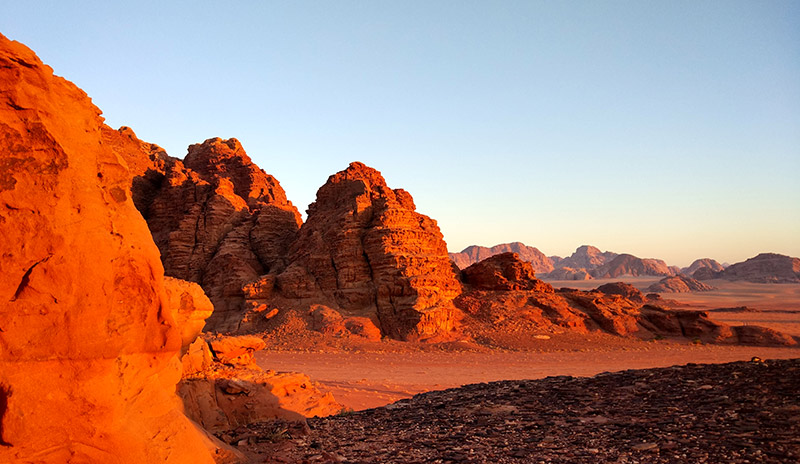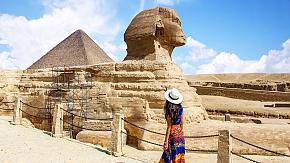10 Interesting Facts About Wadi Rum That Will Surprise You
During your Jordan tour, you may come across the southern desert landscape with red sand and strange-shaped rock formations, which look so alien that it is nicknamed the Valley of the Moon. This is the famous Wadi Rum. You may have heard of it, but may not know the following interesting facts about it.
1. It Is Almost As Large As New York City
Wadi Rum lies in the far south of Jordan, and east of the Rift Valley. It is a large area, about 60km (35 mi) northeast of Aqaba, 100km (60 mi) south of Petra, and 300km (185 mi) south of Amman.
It was officially protected as the Wadi Rum Protected Area in 1997 and now covers an area of 74,200 hectares (about 183,352 acres), nearly as large as New York City (78,380 hectares / 193,484 acres).
2. It Is Mars on Earth
The blood-red sands and the unworldly sandstone mountains create an uncanny Mars-like landscape and environment, making you truly feel like you are stepping foot on another planet, though you are right here on Earth.
 These two people look like they are on a mission on Mars.
These two people look like they are on a mission on Mars.
3. It Is A favorite Hollywood Film Set
With reddish sand and mountains looking like the arid and red surface of Mars, Wadi Rum is a Hollywood favorite for films set on the red planet. So far it has served as the backdrop for many Hollywood films like The Martian (2015), The Last Days on Mars (2013), Red Planet (2000), Mission to Mars (2000), etc. Arthur Max, the production designer of The Martian, says Wadi Rum is "uncannily similar to Mars in its reddish-orange hues".
Many other films also have been filmed in Wadi Rum, like Transformers: Revenge of the Fallen, Prometheus, Lawrence of Arabia, etc.
4. It Is Not Only A Red-Rock Wilderness
Not just sweeping sand dunes and gargantuan rock mountains, a spectacular series of natural arches, towering cliffs, massive landslides, dramatic cavernous weathering forms, and narrow gorges can also be viewed at Wadi Rum.
They all together create an almost fairy-tale setting. The diversity and large scale of landforms, the distant view of both extensive wadis (referring to the bed or valley of a river that is usually dry in Arabic) and narrow canyons, and its reddish-orange hues add to its aesthetic.
 Wadi Rum is really the reddest place of Jordan, colored by iron oxide.
Wadi Rum is really the reddest place of Jordan, colored by iron oxide.
How was this exceptional combination of landforms developed? It is the result of a million years of ongoing evolution influenced by various factors. Including various types of weathering and erosion associated with previous humid climates and later desert climates, tectonic activities (like rapid uplift, numerous faults and joints), and lithology, etc.
More specifically, the spectacular networks of honeycomb weathering features result from "drainage incision, severe weathering by salt, biological and other processes, and the undermining of steep sandstone cliffs by these weathering processes", as researched by UNESCO.
 The magnificent Umm Fruth Rock Bridge
The magnificent Umm Fruth Rock Bridge
5. It Is A Big Open-Air Library
Besides stunning desert landscape, Wadi Rum also boasts astounding cultural landscape. 25,000 petroglyphs (rock carvings), 20,000 inscriptions, and 154 archaeological sites have been discovered within this place, tracing the evolution of human thought and the early development of the alphabet.
The petroglyphs, mostly engraved on rocks, boulders and cliff faces, span all eras from the Neolithic to the Nabataean. They represent figures of human holding bows and arrows, and animals like camel, ibex and horse, as well as symbols like lines and circles, offering a rare window into the long-term patterns of pastoral, agricultural and urban human activities here. These petroglyphs also reveal climate change from mildly humid to the current arid desert.
The numerous inscriptions are mainly in four different scripts, Thamudic, Nabataean, Islamic and Arabic, testify to the widespread literacy among the societies in this Arabian Peninsula.
 These petroglyphs and inscriptions tell us the history and evolution of human habitation in Wadi Rum, as well as the cultural traditions of its early inhabitants.
These petroglyphs and inscriptions tell us the history and evolution of human habitation in Wadi Rum, as well as the cultural traditions of its early inhabitants.
6. It Was An Early Human Habitat
Widespread petroglyphs, inscriptions and archaeological remains illustrate that many humans of different cultures inhabited Wadi Rum as early as 12,000 years ago since prehistoric times and interacted with the natural environment there.
One of its famous inhabitants is the Thamud people living here from at least the 8th century BC, which was a nomadic tribe related to the mysterious Nabateans (builders of Petra) and referred to as Arabs in the Quran.
Currently, its inhabitants are mainly Bedouin, about several hundred of them live in their goat-hair tents and concrete houses in the Rum village. The word bedouin comes from the Arabic badawī, meaning "desert dweller".
7. It Is Adventurer's Paradise
Here you have many chances to take genuine desert adventures. Take a four wheel drive deep into the vast desert, go on a camel safari to explore the rugged landscape, you can easily experience the grandeur that Wadi Rum has to offer.
 Camel riding is one of the most authentic ways to experience Wadi Rum as the slow pace goes well with life in the desert.
Camel riding is one of the most authentic ways to experience Wadi Rum as the slow pace goes well with life in the desert.
You can even soar over Wadi Rum on a hot-air balloon or a light aircraft to admire the wonderland dotted with thousands of dramatic rock formations and other spectacular landscapes in a new way.
For eco-adventure, rock climbing on the sandstone mountains, sandboarding down the sand dunes and hiking around the valley are good choices.
8. It Is A Feast of Colors at Sunset
One of the best moments of a day in Wadi Rum is sitting on a rock and waiting for the breathtaking sunset. As the sun set over the rolling landscape, Wadi Rum lit up into different hues.
You will see the sky slowly changes from an azure blue to a soft blue, to a pale pink, to a brilliant orange, to a burning red, and then to a French grey and light black, and finally completely dark with bright stars shining in the sky. It's truly a feast of changing colors.
 Enjoy the movie-set sunset unfolding in front of you.
Enjoy the movie-set sunset unfolding in front of you.
9. It Is A Real Fairytale Place at Night
Wadi Rum doesn't only look gorgeous in the day. During clear night, when millions of shining stars illuminate the dark sky and the bright moon illuminates the otherworldly landscape, you will feel as if you are in a fairy tale world.
Camping is the best way to enjoy a tranquil and magical night in Wadi Rum. After a traditional dinner, venture into the desert under the cover of darkness. Find an ideal sand dune to lay on the cool sands, enjoy the total silence and peace of the desert, and marvel at the glistening Milky Way a million miles away with your naked eyes thanks to the extremely clear air. Count the endless stars in the sparkling night sky, encounter some shooting stars, and make wishes on them.
10. It Is A Year-Round Destination
Wadi Rum is a year-round destination according to its desert climate. If you prefer pleasant and mild temperature, the best time to visit is March-May and September-November, which are also the most popular and busy months. Spring is especially the best season to see the desert come alive with plants and wildflowers carpeting its floor and cute baby goats and camels dotting the area around Bedouin herds.
Spring is especially the best season to see the desert come alive with plants and wildflowers carpeting its floor and cute baby goats and camels dotting the area around Bedouin herds.
The best time for climbing and hiking is from October to April. A visit in summer and winter may be less comfortable in terms of weather but is rewarding with significantly smaller crowds.
 An adorable baby camel and an adult one.
An adorable baby camel and an adult one.
Plan Your Trip to Morocco With Odynovo
After knowing all these 10 interesting facts about Wadi Rum, will you plan a trip to this red wildness? Should you have any questions about Wadi Rum and trip planning to it, please feel free to contact us at [email protected] .
Quick Question
What Our Clients Say
Explore the latest verified reviews of Odynovo's travel services on Tripadvisor, Google, Trustpilot, Product Review and more trusted platforms.





